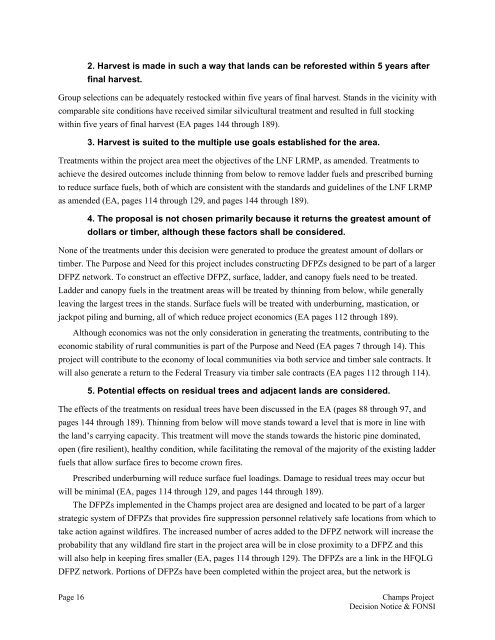Champs Project
Champs Project
Champs Project
Create successful ePaper yourself
Turn your PDF publications into a flip-book with our unique Google optimized e-Paper software.
2. Harvest is made in such a way that lands can be reforested within 5 years after<br />
final harvest.<br />
Group selections can be adequately restocked within five years of final harvest. Stands in the vicinity with<br />
comparable site conditions have received similar silvicultural treatment and resulted in full stocking<br />
within five years of final harvest (EA pages 144 through 189).<br />
3. Harvest is suited to the multiple use goals established for the area.<br />
Treatments within the project area meet the objectives of the LNF LRMP, as amended. Treatments to<br />
achieve the desired outcomes include thinning from below to remove ladder fuels and prescribed burning<br />
to reduce surface fuels, both of which are consistent with the standards and guidelines of the LNF LRMP<br />
as amended (EA, pages 114 through 129, and pages 144 through 189).<br />
4. The proposal is not chosen primarily because it returns the greatest amount of<br />
dollars or timber, although these factors shall be considered.<br />
None of the treatments under this decision were generated to produce the greatest amount of dollars or<br />
timber. The Purpose and Need for this project includes constructing DFPZs designed to be part of a larger<br />
DFPZ network. To construct an effective DFPZ, surface, ladder, and canopy fuels need to be treated.<br />
Ladder and canopy fuels in the treatment areas will be treated by thinning from below, while generally<br />
leaving the largest trees in the stands. Surface fuels will be treated with underburning, mastication, or<br />
jackpot piling and burning, all of which reduce project economics (EA pages 112 through 189).<br />
Although economics was not the only consideration in generating the treatments, contributing to the<br />
economic stability of rural communities is part of the Purpose and Need (EA pages 7 through 14). This<br />
project will contribute to the economy of local communities via both service and timber sale contracts. It<br />
will also generate a return to the Federal Treasury via timber sale contracts (EA pages 112 through 114).<br />
5. Potential effects on residual trees and adjacent lands are considered.<br />
The effects of the treatments on residual trees have been discussed in the EA (pages 88 through 97, and<br />
pages 144 through 189). Thinning from below will move stands toward a level that is more in line with<br />
the land’s carrying capacity. This treatment will move the stands towards the historic pine dominated,<br />
open (fire resilient), healthy condition, while facilitating the removal of the majority of the existing ladder<br />
fuels that allow surface fires to become crown fires.<br />
Prescribed underburning will reduce surface fuel loadings. Damage to residual trees may occur but<br />
will be minimal (EA, pages 114 through 129, and pages 144 through 189).<br />
The DFPZs implemented in the <strong>Champs</strong> project area are designed and located to be part of a larger<br />
strategic system of DFPZs that provides fire suppression personnel relatively safe locations from which to<br />
take action against wildfires. The increased number of acres added to the DFPZ network will increase the<br />
probability that any wildland fire start in the project area will be in close proximity to a DFPZ and this<br />
will also help in keeping fires smaller (EA, pages 114 through 129). The DFPZs are a link in the HFQLG<br />
DFPZ network. Portions of DFPZs have been completed within the project area, but the network is<br />
Page 16 <strong>Champs</strong> <strong>Project</strong><br />
Decision Notice & FONSI
















